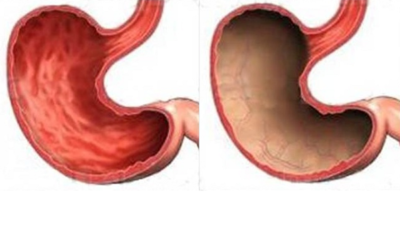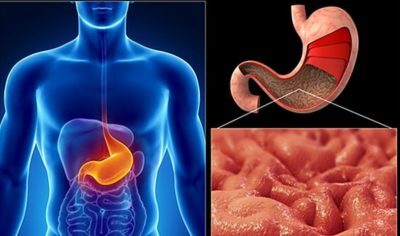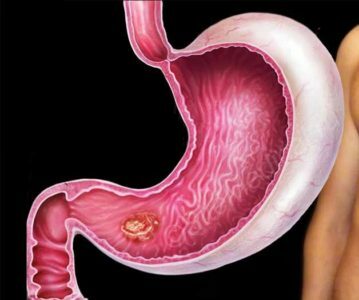1 The main signs and causes of
Hyperplasia of the gastric mucosa is a hidden disease, as a result of which the process of cell division will be indistinguishable from the natural. It is for this reason that the diagnosis becomes possible only in the situation when the disease passes into a neglected stage. And physicians are allocated 2 stages of the disease: diffuse and focal.

Recommended to read
- What is functional stomach ailment
- What is the diagnosis of stomach papillitis
- Authorized and forbidden products with gastric ulcer
- Effective agent for gastritis and stomach ulcer
To date, a large number of different types of disease associated with gastric hyperplasia have been identified and classified. The basis is taken by the place where the focus of pathology will be located, in which organ, the type of cells participating in the pathological process is taken into account.
To the emergence and development of this pathology can lead to various processes, mostly poorly studied. Among the factors that can cause a hyperplasia of the stomach, we can distinguish:
- a violation in the hormonal regulation of the work of various organs;
- ingestion of various infections, most often Helicobacter pylori;
- when there is a disturbance of the nervous regulation of work in the affected organ;
- genetic failures and heredity;
- as a result of exposure to various substances that have carcinogenic properties;
- in inflammatory processes;
- as a result of gastritis or ulceration;
- development of disorders associated with secretory function.
The development of hyperplasia of the gastric mucosa, like other types of this disease, occurs without symptoms. And people do not even feel that they are sick. Especially at the initial stage of the disease. Further, it will only get worse, since the main symptoms begin to manifest. The most common acute pain that occurs after a meal, as well as during a hunger strike, can occur heartburn, constipation and eructation.

2 Species of the disease
Regardless of the parameters, the basis for the manifestation of symptoms is the process of development of hyperplasia. It provokes the occurrence of disorders associated with the functioning of the stomach.
-
 IMPORTANT TO KNOW! Gastritis? Ulcer? To have a stomach ulcer not turned into cancer, drink a glass. ..Read the article & gt; & gt;
IMPORTANT TO KNOW! Gastritis? Ulcer? To have a stomach ulcer not turned into cancer, drink a glass. ..Read the article & gt; & gt;

Medicine identifies a fairly large number of varieties of hyperplasia. Their main difference lies in the peculiarities of the course of the disease, as there are lesions of various parts of the stomach at the cellular level.
As a result, the following types are formed.
Focal type of gastric hyperplasia, characterized by the defeat of certain areas in the mucosa of this organ. In medicine, this pathology is defined as an early form of polyps development. In this case, the focus of the disease can differ in its shape and size. Initially, it can be identified as a small outgrowth with a modified structure. All these species are very well identified during a thorough investigation. Has both single and multiple lesions in the form of tubercles or with a foot. Can occur at the site of erosion.
Development of lymphoid hyperplasia - is a disease of the stomach, in which there is a significant increase in the number of lymphocytes provoking pathological changes. Characterized by the penetration into the blood of various viruses that can trigger a response of the immune system. The processes can develop as a consequence of the pathological process in the lymph nodes.
-
 Gastroenterologist. IMPORTANT: "I beg you, if you began to worry about abdominal pain, heartburn, nausea, do not in any way do gases. .."Read more & gt; & gt;
Gastroenterologist. IMPORTANT: "I beg you, if you began to worry about abdominal pain, heartburn, nausea, do not in any way do gases. .."Read more & gt; & gt;
Lymphofollicular hyperplasia of the stomach is the consequence of a negative effect on the tissue, which leads to a significant increase in cells. The basis for the development of the disease is obesity, various types of violations of the liver, etc.

The appearance of hyperplasia of the integumentary epithelium of the stomach is a very dangerous phenomenon that contributes to the development of malignant tumors. This is due not only to the fact that the epithelium is actively expanding, but its structure also changes.
3 Similar pathologies
Hyperplasia of the antral part of the stomach is a lesion of this department, which closes the stomach itself and serves to release food further into the intestine. The peculiarity is that the affected antral department occupies the most part of the organ and is required to withstand heavy loads. It is for this reason that the occurrence of problems or diseases can affect the process of digestion of food, as there is a penetration of various infections, as well as bacteria Helicobacter pylori as a result of weakened immunity.
The development of glandular hyperplasia lies in the fact that in this pathology there is hyperplasia of the cells of the mucous membrane and glands functions. As a result, a process of formation of various growths having a polypoid shape occurs. It is worth noting that this type of disease is very rare.
ADVICE FROM THE MAIN GASTROENTEROLOGIST
Korotov SV: "I can recommend only one remedy for the rapid treatment of Ulcer and Gastritis, which is now recommended by the Ministry of Health. .." Read testimonials & gt; & gt;
The occurrence of polypoid hyperplasia is not only a common, but also a dangerous kind of disease. Most often in medicine is called "hyperplastic polyp."Beginning as a benign neoplasm, later it can expand and turn into a malignant one.
It is worth mentioning that the medicine not only failed to find out the reasons, but also the processes occurring during the hyperplasia disease. Most often, the chronic illness of the food tract, including infections, is taken as a basis. All this leads to the appearance of wounds on the walls of the stomach.
The only way to protect is to prevent and take care of the health of the entire food tract.
- 1 Main signs and causes of
- 2 Diseases of the disease
- 3 Similar pathologies
Hyperplasia of the gastric mucosa is a severe pathological proliferation of tissue. It arises as a result of sharp and enhanced cell division. The peculiarity of the disease lies in the fact that it can occur practically in all organs and tissues of a person. But most often they are affected by the gastric mucosa. The main danger lies in the fact that hyperplasia can promote the development of tumors, and, therefore, eventually become the cause of cancerous tumors.
Do you have gastritis?
GALINA SAVINA: "How easy is it to cure gastritis at home for 1 month. A proven method - write down a recipe. ..!"Read more & gt; & gt;
In some cases, the disease can lead to changes in the structure of cells, provoking the development of a process associated with the formation of a malignant tumor.



